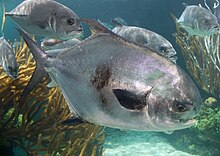Trachinotinae
Appearance
| Trachinotinae Temporal range:
| |
|---|---|

| |
| Leerfish (Lichia amia) | |

| |
| Permit Trachinotus falcatus | |
| Scientific classification | |
| Domain: | Eukaryota |
| Kingdom: | Animalia |
| Phylum: | Chordata |
| Class: | Actinopterygii |
| Order: | Carangiformes |
| Suborder: | Carangoidei |
| Family: | Carangidae |
| Subfamily: | Trachinotinae Gill, 1861[1] |
| Genera | |
| |
Trachinotinae is a subfamily of the family Carangidae, the jacks and pompanos.
Genera
[edit]Two genera are placed in the Trachinotinae:[2]
The earliest known member of this subfamily is Lichia veronensis from the Early Eocene of Monte Bolca, Italy.[5] The fossil genus Paratrachinotus was sometimes placed in this subfamily, but more recent studies suggest that it belongs in its own clade.[6]
References
[edit]- ^ Richard van der Laan; William N. Eschmeyer & Ronald Fricke (2014). "Family-group names of Recent fishes". Zootaxa. 3882 (2): 001–230. doi:10.11646/zootaxa.3882.1.1. PMID 25543675.
- ^ J. S. Nelson; T. C. Grande; M. V. H. Wilson (2016). Fishes of the World (5th ed.). Wiley. p. 386. ISBN 978-1-118-34233-6.
- ^ Eschmeyer, William N.; Fricke, Ron & van der Laan, Richard (eds.). "Lichia". Catalog of Fishes. California Academy of Sciences. Retrieved 17 November 2019.
- ^ Eschmeyer, William N.; Fricke, Ron & van der Laan, Richard (eds.). "Trachinotus". Catalog of Fishes. California Academy of Sciences. Retrieved 17 November 2019.
- ^ Carnevale, G.; Bannikov, Alexandre F.; Marramà, G.; Tyler, James C.; Zorzin., R. (2014). "The Bolca Fossil-Lagerstätte: A window into the Eocene World. 5. The Pesciara- Monte Postale Fossil-Lagerstätte: 2. Fishes and other vertebrates. Excursion guide" (PDF). Rendiconti della Società Paleontologica Italiana. 4 (1): i–xxvii. hdl:10088/25678.
- ^ Springer, Victor G.; Smith-Vaniz, William F. (2008). "Supraneural and pterygiophore insertion patterns in carangid fishes, with description of a new Eocene carangid tribe, †Paratrachinotini, and a survey of anterior anal-fin pterygiophore insertion patterns in Acanthomorpha". Bulletin of the Biological Society of Washington. 16 (1): 1–73. doi:10.2988/0097-0298(2008)16[1:SAPIPI]2.0.CO;2. ISSN 0097-0298.
